Categories: Featured Articles » Sources of light
Number of views: 92747
Comments on the article: 12
Ten modern trends in interior lighting
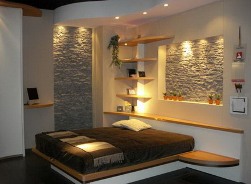 I must say right away that I am not professionally engaged in lighting design and I am not a specialist in this field. I was always more interested in technical issues in the lighting of rooms (lighting calculations, various light sources, automation and lighting control) Although I really like beautiful interiors and can spend hours watching thick glossy magazines on room design, construction and repair with bright color pictures. I especially like magazines with photo examples of real projects. My favorite magazines of this type are Major House and Beautiful Apartments.
I must say right away that I am not professionally engaged in lighting design and I am not a specialist in this field. I was always more interested in technical issues in the lighting of rooms (lighting calculations, various light sources, automation and lighting control) Although I really like beautiful interiors and can spend hours watching thick glossy magazines on room design, construction and repair with bright color pictures. I especially like magazines with photo examples of real projects. My favorite magazines of this type are Major House and Beautiful Apartments.
Flipping through this type of magazine, first of all, I pay attention to how the coverage is organized in a particular case. At the same time, somehow imperceptibly for yourself, you begin to notice and clearly realize the general trends in the development of home lighting: what lamps and fixtures are used, how they are placed, how the illuminated interior looks from different angles, and much more.
The other day, having talked with one young and pretty girl-designer, I came to the conclusion that she agreed with everything that I enthusiastically set out to her, there are certain trends in the lighting of interiors and they have the right to be voiced. Well, as I can voice all my thoughts through the site, now I will do this. I hope you do not remain indifferent, but leave your opinion about this material in the comments! This is very important to me!
So, in this article I want to share my observations with the readers of the site. What are the current trends in interior lighting? How are new ideas implemented? What modern technical solutions are applied? What good can we get by putting into practice these modern trends in lighting design?
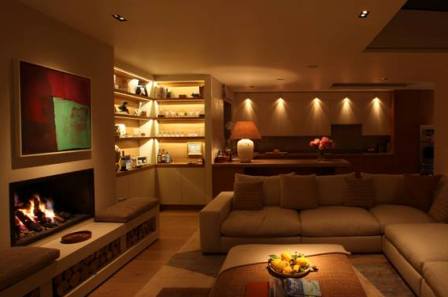
1. The use of multi-level lighting
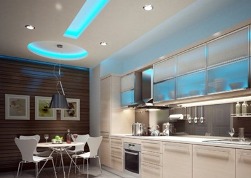 More recently, the norm in lighting the interior was the presence in the room of only 1-2 lamps. In all modern projects from design magazines that I have met, residential lighting has been built on several levels at once.
More recently, the norm in lighting the interior was the presence in the room of only 1-2 lamps. In all modern projects from design magazines that I have met, residential lighting has been built on several levels at once.
Everywhere there is an overhead light, light from wall lamps, light at the floor level, additional levels with illumination of various paintings and interior elements, i.e. There is a clear tendency in the lighting of modern interiors to use a tiered (multi-level) arrangement of light sources. This allows you to preserve the three-dimensional space of the room when lighting, visually emphasize the depth and comfort.
With multi-level lighting, the room becomes more functional. Such lighting makes it easy to transform the space and get different effects when turning on and off individual light sources.
2. The use of low light from fixtures embedded in the floor
It has become very fashionable to use such lamps to highlight specific objects or vertical surfaces. Light comes from below and this in itself is already unusual and very beautiful. Placing fixtures in the floor allows you to create an additional tier in the lighting.
Naturally, simply installing fixtures in the floor wherever is not enough. It is necessary to think over and calculate everything, and still clearly imagine the end result of what effect you want to get with the help of such an unusual and technically difficult placement of lamps. For these purposes, it is advisable to use LED lamps, as they do not heat up and emit quite bright light.
3. Active use of LED light sources
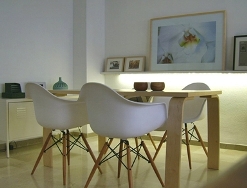 As a famous lighting engineer once said: "Soon, all the lighting will be LED." And I completely agree with him.
As a famous lighting engineer once said: "Soon, all the lighting will be LED." And I completely agree with him.
LED technology is becoming increasingly popular in the world of lighting, LED lamps have become the main characters in the catalogs of the vast majority of manufacturers of lighting products, are present at most exhibitions and more often in our homes. LED lamps consume very little power and have an almost endless life.
The vast majority of manufacturers are actively working to improve the performance of LED lamps; large amounts of money are invested in the design of high-performance reflectors to maximize the amount of light emitted. In addition, new ways are being sought to remove heat from the LEDs.
Manufacturers have found that consumers require warm tones of light, simply because of their resemblance to existing traditional light sources. For this reason, this trend is leading to an increase in LEDs with a color temperature at or below 2700 ° K and having a more uniform spectrum.
Currently available LED lamp for replacing incandescent lamps up to 100 watts. The next step will be to reduce the cost of production of LED lamps, which will allow even more active use of LED lamps in home lighting.
4. The use of modern lighting systems with moving lights
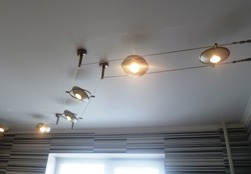 One of the most interesting trends in interior lighting design is the use of various lighting systems that easily allow you to change the direction of the light flux of the lamps. So, the built-in and pendant rotary lamps, track and cable lighting systems.
One of the most interesting trends in interior lighting design is the use of various lighting systems that easily allow you to change the direction of the light flux of the lamps. So, the built-in and pendant rotary lamps, track and cable lighting systems.
Such lamps can be turned in any direction, while changing the direction of the light and getting a new option for lighting the room.
These new technical solutions can significantly expand the possibility of using lighting in rooms, since using the same lamps you can get both general uniform and, if desired, directional lighting. In addition, track and cable lighting systems make it easy to place lights without fixing them on the ceiling, which is sometimes quite difficult to do in rooms with complex ceilings.
5. Lighting for niches and openings
During the construction or repair of the premises, a small niche is specially organized. It subsequently houses vases with flowers, figurines or other decorative objects that are beautifully illuminated by a built-in niche above or below. spotlights.
Thanks to this, an additional volume appears in the room, the space expands, the highlighted niche becomes the focal point and decoration of the entire room. In addition, with the help of such a niche an additional tier of light appears in the room.
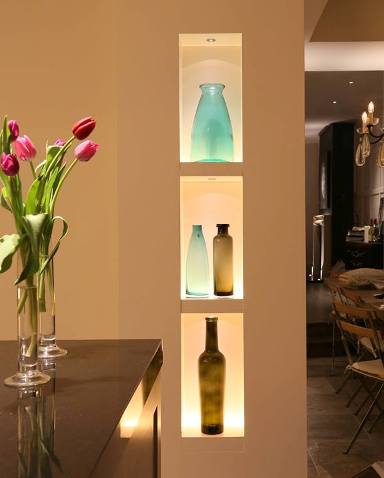
6. Combination of different light sources
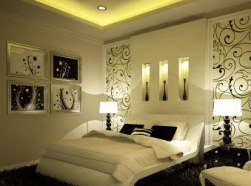 Not long ago, incandescent lamps were used almost exclusively in room lighting. Nowadays, the production of light sources was primarily focused on solving energy saving issues, so it has become very fashionable to use various energy saving lampsFirst of all, compact fluorescent and LED.
Not long ago, incandescent lamps were used almost exclusively in room lighting. Nowadays, the production of light sources was primarily focused on solving energy saving issues, so it has become very fashionable to use various energy saving lampsFirst of all, compact fluorescent and LED.
Quite conditionally, energy-saving can be attributed to modern halogen lamps. Moreover, in almost all projects there is a combination of various light sources. In interior lighting, they successfully complement each other.
Compact fluorescent lamps are used for general uniform illumination of rooms, linear fluorescent or LED rulers are used to obtain a hidden light strip, halogen for general localized (built-in lamps), halogen and LED for creating focal points, halogen, LED light sources for decorative lighting and fiber optic systems.
7. The use of hidden light
It has become very fashionable to make hidden lighting in rooms, i.e. when there is light, but the light source is not visible.Typically, hidden lighting is placed on top of cabinets, along shelves, on a multi-level ceiling of a special design. To obtain hidden lighting, linear light sources are most often used.
With the help of hidden lighting, the interior of the room becomes more lively and attractive. Most often, in the same way, they organize not the main, but the additional background lighting in the room. A hidden light source gently illuminates the room, making it warm and cozy.
8. Changing the brightness of light sources
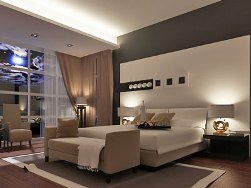 One of the most fashionable trends in home lighting is the widespread use. dimmers - electrical devices for changing the brightness of light sources.
One of the most fashionable trends in home lighting is the widespread use. dimmers - electrical devices for changing the brightness of light sources.
If the room has several light sources at different levels, then using dimmers you can very easily change the light environment in the room.
So, by dimming the upper light, but leaving luminous lamps to illuminate the paintings, you can make art objects a focal point, and by controlling the brightness of the floor lamp and lamps at the floor level, you can achieve unusual comfort and beauty.
Dimmer control can be programmed and automated. In fact, the active use of dimmers in a room with programmed lighting scenes is one of the first steps to smart home organization.
In addition to all lighting effects and the convenience of controlling light sources, dimmers have several other advantages - they allow you to extend the life of the lamps and save electricity.
9. Use of small portable lights
It is popular among lighting designers to use small fixtures with a narrow beam of light. Thanks to them, you can change the atmosphere in the room with the help of lighting almost several times a day and get different lighting effects.
The main advantage of such lamps is their mobility. They allow you to change or supplement the existing lighting scheme in the room without global alterations and repairs.
By simply bringing in a new light source and highlighting, for example, a beautiful wall in the corner of the room, or a large vase, we not only create a new focus of light, but also an additional level of lighting.
True, for the full use of small portable fixtures, it is desirable to have many sockets in the room in different places, so that as little as possible use extension cords for such lamps. And it will be all beautiful, but you have to constantly stumble over twisted wires.
10. The use of decorative lighting
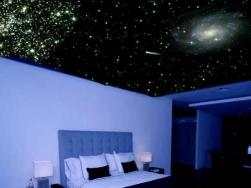 Another very fashionable trend is the use of colored decorative lighting to create a certain mood. For these purposes, the project uses lamps that can change the color of the emitted light.
Another very fashionable trend is the use of colored decorative lighting to create a certain mood. For these purposes, the project uses lamps that can change the color of the emitted light.
LEDs and fiber optic systems are popular. With the help of such light sources, various unusual special effects are obtained. Very original look ceilings with glowing starry skyflickering walls and dance floor in the living room. Here, of course, everything is an amateur, but unexpectedly surprising guests with such things is always funny.
Who knows, maybe in a couple of years such things will no longer be able to surprise and delight someone, as they will become commonplace and everyone in the house will have several dance floors and shimmering walls at once :-) At least in the field of home lighting, everything is developing so quickly that I myself will soon forget how to be surprised.
Well, at the end of the article I recommend one wonderful book for study. From what I read on the subject of lighting design, I was most impressed with the book by Lucy Martin "Effects of home lighting".
The book presents more than 200 original ideas for interior design, with which you can transform any home with the help of light. The book is actually very beautiful and helpful. See my review of this book here: Home lighting effects.
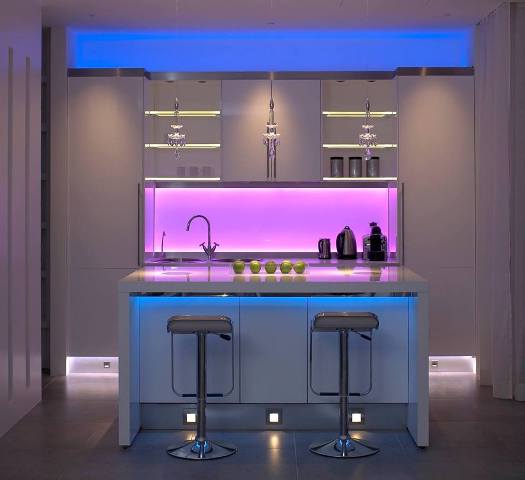
If it’s not difficult for you, leave your comment on the article! Your opinion is very interesting to me!
See also at e.imadeself.com
:
